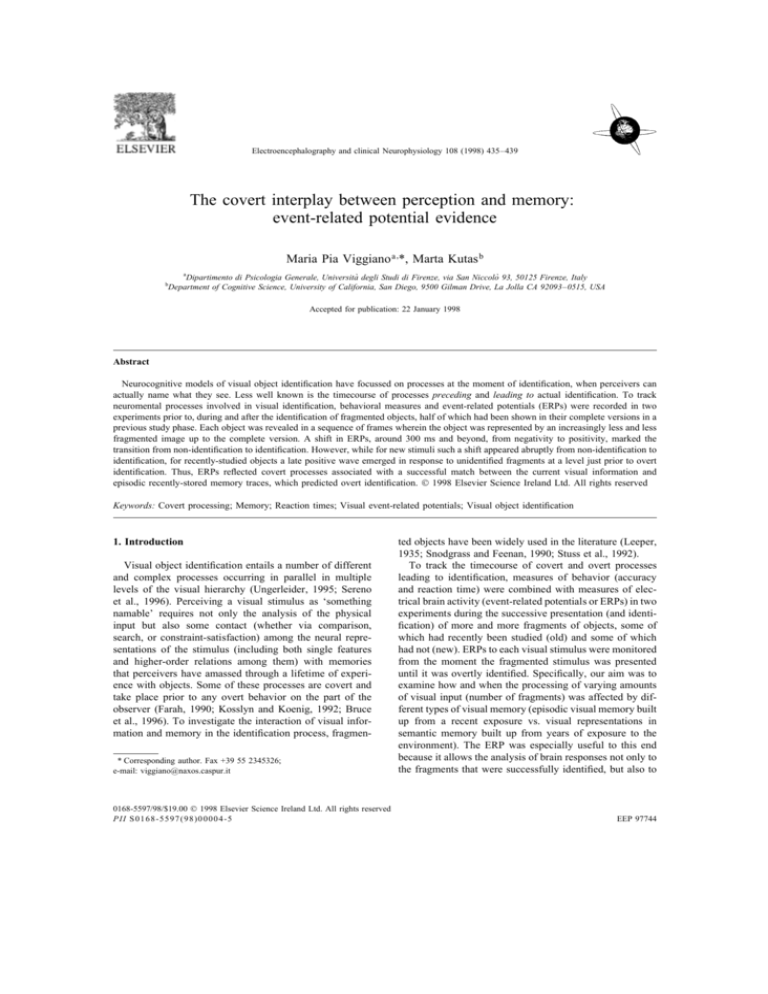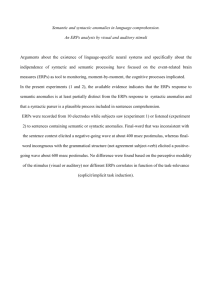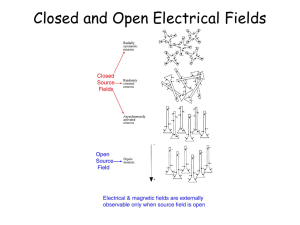
Electroencephalography and clinical Neurophysiology 108 (1998) 435–439
The covert interplay between perception and memory:
event-related potential evidence
Maria Pia Viggiano a ,*, Marta Kutas b
a
Dipartimento di Psicologia Generale, Università degli Studi di Firenze, via San Niccolò 93, 50125 Firenze, Italy
Department of Cognitive Science, University of California, San Diego, 9500 Gilman Drive, La Jolla CA 92093–0515, USA
b
Accepted for publication: 22 January 1998
Abstract
Neurocognitive models of visual object identification have focussed on processes at the moment of identification, when perceivers can
actually name what they see. Less well known is the timecourse of processes preceding and leading to actual identification. To track
neuromental processes involved in visual identification, behavioral measures and event-related potentials (ERPs) were recorded in two
experiments prior to, during and after the identification of fragmented objects, half of which had been shown in their complete versions in a
previous study phase. Each object was revealed in a sequence of frames wherein the object was represented by an increasingly less and less
fragmented image up to the complete version. A shift in ERPs, around 300 ms and beyond, from negativity to positivity, marked the
transition from non-identification to identification. However, while for new stimuli such a shift appeared abruptly from non-identification to
identification, for recently-studied objects a late positive wave emerged in response to unidentified fragments at a level just prior to overt
identification. Thus, ERPs reflected covert processes associated with a successful match between the current visual information and
episodic recently-stored memory traces, which predicted overt identification. 1998 Elsevier Science Ireland Ltd. All rights reserved
Keywords: Covert processing; Memory; Reaction times; Visual event-related potentials; Visual object identification
1. Introduction
Visual object identification entails a number of different
and complex processes occurring in parallel in multiple
levels of the visual hierarchy (Ungerleider, 1995; Sereno
et al., 1996). Perceiving a visual stimulus as ‘something
namable’ requires not only the analysis of the physical
input but also some contact (whether via comparison,
search, or constraint-satisfaction) among the neural representations of the stimulus (including both single features
and higher-order relations among them) with memories
that perceivers have amassed through a lifetime of experience with objects. Some of these processes are covert and
take place prior to any overt behavior on the part of the
observer (Farah, 1990; Kosslyn and Koenig, 1992; Bruce
et al., 1996). To investigate the interaction of visual information and memory in the identification process, fragmen* Corresponding author. Fax +39 55 2345326;
e-mail: viggiano@naxos.caspur.it
0168-5597/98/$19.00 1998 Elsevier Science Ireland Ltd. All rights reserved
PII S0168-5597 (98 )0 0004-5
ted objects have been widely used in the literature (Leeper,
1935; Snodgrass and Feenan, 1990; Stuss et al., 1992).
To track the timecourse of covert and overt processes
leading to identification, measures of behavior (accuracy
and reaction time) were combined with measures of electrical brain activity (event-related potentials or ERPs) in two
experiments during the successive presentation (and identification) of more and more fragments of objects, some of
which had recently been studied (old) and some of which
had not (new). ERPs to each visual stimulus were monitored
from the moment the fragmented stimulus was presented
until it was overtly identified. Specifically, our aim was to
examine how and when the processing of varying amounts
of visual input (number of fragments) was affected by different types of visual memory (episodic visual memory built
up from a recent exposure vs. visual representations in
semantic memory built up from years of exposure to the
environment). The ERP was especially useful to this end
because it allows the analysis of brain responses not only to
the fragments that were successfully identified, but also to
EEP 97744
436
M.P. Viggiano, M. Kutas / Electroencephalography and clinical Neurophysiology 108 (1998) 435–439
those that were not overtly identified. Thus, covert processes involved in the interplay between visual input and
memory, which were not be revealed by behavioral measures, could be investigated via ERP recordings. In order to
verify the extent to which the main results obtained in
Experiment 1 depended on the level of subjects’ certainty
in identifying the objects, subjects’ degree of confidence
was investigated in Experiment 2.
2. Method
2.1. Subjects
Having giving written informed consent, 17 adults (9
women), between 19 and 30 years of age, participated in
Experiment 1. Eighteen adults (8 women), between 19 and
30 years of age, participated in Experiment 2. All participants had normal or corrected-to-normal vision and were
right-handed.
2.2. Stimuli
One hundred and fifty line-drawings of common objects
spanning a number of categories (e.g. animals, clothes,
vehicles, tools) were used (from the series by Snodgrass et
al., 1987). Each drawing was presented on a CRT under the
control of a personal computer. Each stimulus subtended
between 5° and 10° of visual angle along both vertical
and horizontal dimensions.
2.3. Electrophysiological recording
The electroencephalogram was recorded via tin electrodes embedded in an elastic cap from 19 scalp locations of
the international 10–20 system (Jasper, 1958) including
frontal (Fz, Fp1, Fp2, F2, F3, F7, F8), central (Cz, C3,
C4), parietal (Pz, P3, P4), temporal (T3, T4, T5, T6) and
occipital (O1, O2) sites. An electrode over the left mastoid
process served as a reference during recording; the data
were re-referenced off-line to the average of the voltage
activity at the left and right mastoids. Recordings between
electrodes placed lateral to each eye were used to monitor
horizontal eye movements, and an electrode below the right
eye was used to monitor vertical eye movements and blinks.
These potentials were used to eliminate artifactually-contaminated trials (roughly 10%). The electrical activity was
amplified with a bandpass of 0.01–100 Hz and digitized at
250 Hz. ERPs were computed for epochs extending from
200 ms before to 1600 ms after image onset. Mean amplitude measurements were taken within designated latency
ranges (300–600, 600–1000, 1000–1300, 1300–1600 ms)
relative to the average amplitude in the 200 ms prior to each
stimulus, in some cases base-to-peak amplitudes were also
measured. All measurements were submitted to repeatedmeasures analyses of variance. The Greenhouse-Geisser
correction for violations of sphericity was applied to all
treatments with more than one degree of freedom in the
numerator. The Tukey procedure was used for all post-hoc
comparisons.
2.4. Procedure
Participants were tested individually in an electricallyisolated and sound-attenuating chamber. In the study
phase of Experiment 1, 75 line drawings of ‘complete’
objects (fragmentation level 8) were flashed for 700 ms
each. Approximately 1300–1800 ms before each object,
the word ‘name’ or ‘draw’ appeared on the screen, informing participants of their task for the next object, 38 objects
were named and 37 drawn. During the subsequent identification phase, all 75 objects from the study phase were intermingled with 38 new objects and presented randomly, one
at a time, for identification. Each object was presented at 6
fragmentation levels (2,3,4,5,6 and 8) in an ascending
sequence of frames from the most fragmented (level 2) to
Fig. 1. An example of the ascending sequence of 6 levels of fragmentation for a ‘piano’ as presented during the identification phase. RTs and ERPs were
analyzed relative to the fragmentation level at which identification (ID) occurred. If, for example, this object was identified at level 5 (ID), then two levels
before (2b) refers to fragmentation level 3 and one level before (1b) refers to fragmentation level 4.
M. Pia Viggiano, M. Kutas / Electroencephalography and clinical Neurophysiology 108 (1998) 435–439
the least fragmented, i.e. complete, version (level 8) (Fig. 1).
Every object was shown at all 6 fragmentation levels (for
500 ms each), regardless of the level at which it was actually
identified. Participants were asked to press two buttons, one
if they identified the objects and the other if they did not.
The same procedure was used in Experiment 2, with the
following exceptions: (1) in the study phase all the objects
were drawn, (2) in the identification phase each object was
presented at 7 levels of fragmentation (fragmentation level 7
was added). At each level, individuals pressed one of two
buttons to indicate whether or not they could identify the
object; two presses on the same button indicated high
response certainty (‘no-no’ or ‘yes-yes’) whereas one
press indicated a simple ‘yes’ or ‘no’. Following a ‘yes’
or a ‘yes-yes’ response, participants were asked to name
the object and were given feedback as to the correctness
of their identification.
Given this design, the accuracy and speed of identification (and non-identification) of any given object could be a
function of different memory traces (a specific episode for
studied drawings vs. at best a generic image against which
to compare new pictures), different types of encoding and
processing (naming vs. drawing for old pictures), and information quality (levels of fragmentation for both old and new
pictures).
437
Fig. 3. Overlapped are grand average ERPs recorded from midline frontal,
central and parietal recording sites to fragmented objects at the moment
identification (solid line), at 1-fragment level before ID (dashed line) and
at 1-fragment level before ID (dotted line). This comparison is shown
separately for the objects that had previously been named (left column),
drawn (middle column), or were new (right column). Waveforms are
plotted negative-up in this and all subsequent figures.
3. Results
3.1. Experiment 1
Fig. 2. (A) Mean cumulative percentage of correct identifications at each
level of fragmentation for old (drawn and named) and new objects. (B)
RTs were recorded at two levels before (2b), one level before (1b) and
identification moment (ID) for old (drawn and named) and new objects.
As the number of available fragments increased, identification performance improved for all objects. Fewer fragments were needed to identify previously-studied objects
than new ones (P , 0.00001); and fewer fragments were
needed to identify drawn than named objects, (P , 0.01)
(Fig. 2A). Previous exposure also speeded not just ‘yesresponse’ times at identification (P , 0.001) but also ‘noresponse’ times at the fragmentation level immediately
before identification (P , 0.0001), (Fig. 2B), suggesting
that adding explicit memories to incoming stimuli speeded
their perception more than adding generic memories. However, no significant reaction time (RT) change was found to
mark the actual transition from unsuccessful to successful
identifications. Thus, the only unequivocal overt sign that
perceivers had achieved identification was that they correctly named the object. By contrast, a very large, late positive ERP component beginning around 300 ms and peaking
at 700–800 ms signaled successful overt identification. This
effect was evident at all recording leads (the following statistical data included recordings from all electrodes). The
transition was manifest in a shift from a late negativity to a
positivity in the ERPs, going from unidentified to identified
fragments for both old (drawn and named) and new objects
(P , 0.0001 for all windows from 300 to 1300 ms, and P ,
0.01 for the window 1300–1600 ms). The critical comparison was between ERPs to unidentified fragmented objects
438
M.P. Viggiano, M. Kutas / Electroencephalography and clinical Neurophysiology 108 (1998) 435–439
Fig. 4. Overlapped are grand average ERPs from the midline central site
(Cz) to fragmented objects in the Name, Draw, and New conditions at the
moment of identification (solid line) and at the immediately following
level (dotted line).
(2-levels before identification), which were later identified
but only after a substantial increase in the number of fragments and ERPs to unidentified fragmented objects (1-level
before identification), which were identified with the addition of only a few more fragments. ERPs at 1-level before
were more positive than those at 2-levels before identification for old (drawn and named), but not for new objects
(P , 0.05). As shown in Fig. 3, at 2-levels before identification, ERPs to both old and new objects were characterized
by a large, late negative wave. However, at the level just
prior to the identification (1-level before), ERPs to new
objects continued to show a large negativity whereas, surprisingly, ERPs to old objects showed a late negativity foreshortened by a smaller and later version of the positivity
marking overt identification. This late positivity preceded
the non-identification RTs for these fragments by about 200
ms. At the moment of actual identification there were no
differences between ERPs to fragments of old and new
objects (Fig. 3). After identification, the late positivity had
a sharper slope of onset, an earlier peak, and a shorter duration than at identification (P , 0.00001) (Fig. 4).
before was more positive for ‘no’ than for ‘no-no’ responses
(P , 0.01). The late positivity, present particularly for studied objects, associated with a less certain response (‘no’),
suggests that the response system can tap into the identification decision of which the person was not yet fully aware
(Fig. 5). Response certainty also interacted with previous
exposure at identification: ERPs were generally more positive for decisions rendered with higher (‘yes-yes’) than
lower (‘yes’) certainty (Wilkinson and Seales, 1978) from
300 to 1600 ms (e.g. 600–1000 ms, P , 0.025). In the same
window there was also a significant study by response-certainty interaction (P , 0.025) indicating that the effect was
quite large for new objects and unremarkable for studied
objects (Fig. 6).
4. Discussion
The identification of visual input as a namable object
requires a finite amount of time, albeit less time the better
the quality of the input and the more recent and concrete the
memories which supported its visual analysis. While this
dynamic interplay between the visual input and of the memory was only partially apparent in overt behavior (e.g.
greater accuracy and speed for old objects) and was in
large part not available to conscious recollection, it was
reflected in the brain’s electrical activity. Upon initial exposure to some object, as in Fig. 1, its identification is contingent on matches between the specific sensory representation(s) of this input and some prototypic or abstract
representation of ‘piano’ built from years of experience
with pianos (whether the prototype was a stored average
or one computed online from existing token representations). After the initial exposure, however, identification
3.2. Experiment 2
The extent to which the different patterns of ERPs for old
and new objects at 1-level before identification could be due
to variation in participants’ response certainty was examined in a second experiment. Thus, participants were asked
to indicate the certainty of their decision by pressing the
‘yes’ or ‘no’ button either once if they were certain or
twice if they were very certain that they could or could
not identify the object, respectively. The main findings
from the first experiment were replicated: an abrupt shift
from negativity to positivity for new objects and a gradual
shift for old ones (P , 0.05) (Fig. 5). In addition, the pattern of ERPs to unidentified objects with response certainty
held constant was examined and a relationship between
previous exposure, response certainty and the presence of
the late positivity in the ERP in response to the fragmentation level just before identification was found. For new
objects no significant difference was found between 2-levels
and 1-level before for either ‘no’ or ‘no-no’ responses, while
for drawn objects the 2-levels before versus the 1-level
Fig. 5. Grand average ERPs from midline parietal (Pz) site for drawn and
new objects in Experiment 2. In the left column, ERPs are overlapped for
fragments at the moment of identification (solid line), 1-level before ID
(dashed line), and 2-levels before ID (dotted line) regardless of response
certainty. In the middle and right-hand columns, the ERPs to unidentified
objects (i.e. the same data as in levels 1 and 2 before ID in the left-hand
column) are shown separately for the ‘no’ and ‘no-no’ responses; overlapped are the ERPs to 1-level versus 2-levels before ID.
M. Pia Viggiano, M. Kutas / Electroencephalography and clinical Neurophysiology 108 (1998) 435–439
439
Acknowledgements
The research was supported in part by grants AG08313
and MH52893 to M.K., M.P.V. was supported by a postdoctoral fellowship from the McDonnell-Pew Cognitive
Neuroscience Institute at UCSD. The helpful comments of
J. Weckerly and the technical assistance of R. Ohst are
much appreciated.
References
Fig. 6. Grand average ERPs from a midline site comparing certain (‘yes’)
with very certain (‘yes-yes’) responses at the moment of identification for
drawn and new objects in Experiment 2.
processes could also utilize (at least for a short while),
newly-formed partial or whole representations of the particular object (i.e. token) just experienced (Treisman, 1992;
Knowlton and Squire, 1993; Ishai and Sagi, 1995). Indeed,
one beneficial consequence of drawing or naming objects
shown in their entirety was the creation of such memory
traces (tokens) to which the sensory representations of the
fragmented visual input pattern could later be anchored. The
late positivity in the ERP to fragments of previously-studied
objects just prior to their identification reflected some aspect
of this ‘search and match’ operation of the input with recent
episodic traces. Consistent with what is known from the
literature on the identification of fragmented stimuli (Snodgrass and Feenan, 1990; Roediger and McDermott, 1993;
Snodgrass and Hirschman, 1994; Zhang et al., 1997), these
memory traces appeared to prime the overt identification of
recently-studied fragmented objects. However our ERP (and
behavioral) results show that the priming effects are not
restricted to the moment of overt identification, influencing
processing prior to identification as well.
In conclusion, visual awareness associated with overt,
conscious identification was preceded by unconscious
brain activity that reflected settling into the best perceptual
solution, which was made all the more attractive when it
triggered a clear memory, even if it was not conciously
recollected. The present data show that not only are we
unaware of the early stages of basic visual processing in
V1, as suggested by Crick and Koch (1995), but also of
much higher-order processing further in the visual hierarchy. ERP recordings revealed the covert identification that
anticipated the subsequent overt identification of objects for
which episodic memory traces were recently stored and
acted as primes. A dissociation between covert electrophysiological and overt behavioral data, similarly to what has
been shown in amnesics (Lalouschek et al., 1997), might be
found in brain-injured patients who show by their actions
that they know what the object is and what it is typically
used for but cannot name it. In these anomic patients, ERPs
might signal the identification in the absence of naming
ability.
Bruce, V., Green, P.R. and Georgeson, M.A. Visual Perception: Physiology, Psychology, and Ecology. Psychology Press, Hove, 1996.
Crick, F. and Koch, C. Are we aware of neural activity in primary visual
cortex?. Nature, 1995, 375: 121–123.
Farah, M. Visual Agnosia: Disorders of Object Recognition and What
They Tell Us About Normal Vision. MIT Press, Cambridge, MA, 1990.
Ishai, A. and Sagi, D. Common mechanisms of visual imagery and
perception. Science, 1995, 268: 1772–1774.
Jasper, H.H. The ten-twenty electrode system of the International
Federation. Electroenceph. clin. Neurophysiol., 1958, 10: 371–375.
Knowlton, B.J. and Squire, L.R. The learning of categories: parallel brain
systems for item memory and category knowledge. Science, 1993, 262:
1747–1749.
Kosslyn, S.M. and Koenig, O. Wet Mind. The New Cognitive Neuroscience. Free Press, New York, NY, 1992.
Lalouschek, W., Goldenberg, A., Marterer, R., Beisteiner, R., Lindinger,
G. and Lang, W. Brain/behaviour dissociation on old/new distinction in
a patient with amnesic syndrome. Electroenceph. clin. Neurophysiol.,
1997, 10: 371–375.
Leeper, R. A study of a neglected portion of the field of learning – the
development of sensory organization. J. Genetic Psychol., 1935, 46: 41–
75.
Roediger, H.L., III, and McDermott, K.B. Implicit memory in normal
human subjects. In H. Spinnler and F. Boller (Eds.), Handbook of Neuropsychology (Vol. 8). Elsevier, Amsterdam, 1993, pp. 63–131.
Sereno, M.I., Dale, A.M., Reppas, J.B., Kwong, K.K., Belliveau, J.W.,
Brady, T.J., Rosen, B.R. and Tootell, R.B. Borders of multiple visual
areas in humans revealed by functional magnetic resonance imaging.
Science, 1996, 273: 889–893.
Snodgrass, J.G. and Feenan, K. Priming effects in picture fragment completion: support for the perceptual closure hypothesis. J. Exp. Psychol.:
Gen., 1990, 119: 276–296.
Snodgrass, J.G., Smith, B., Feenan, K. and Corwin, J. Fragmenting pictures on the Apple Macintosh computer for experimental and clinical
applications. Behav. Res. Meth. Instr. Comput., 1987, 19: 270–274.
Snodgrass J.G. and Hirschman, E. Dissociation among implicit and explicit memory tasks: the role of stimulus similarity. J. Exp. Psychol.:
Learn. Mem. Cog., 1994, 20: 150–160.
Stuss, D.T., Picton, T.W., Cherry, A.M., Leech, E.E. and Stethem, L.
Perceptual closure and object identification: electrophysiological responses to incomplete pictures. Brain Cogn., 1992, 19: 253–266.
Treisman, A. Perceiving and re-perceiving objects. Amer. Psychologist,
1992, 47: 862–875.
Ungerleider, L.G. Functional brain imaging studies of cortical mechanisms
for memory. Science, 1995, 270: 769–775.
Wilkinson, R.T. and Seales, D.M. EEG event-related potentials and
detection. Biol. Psychol., 1978, 7: 13–28.
Zhang, X.L., Begleiter, H., Porjesz, B. and Litke, A. Visual object priming
differs from visual word priming: an ERP study. Electroenceph. clin.
Neurophysiol., 1997, 102: 200–215.







